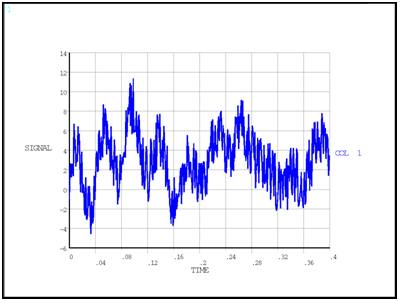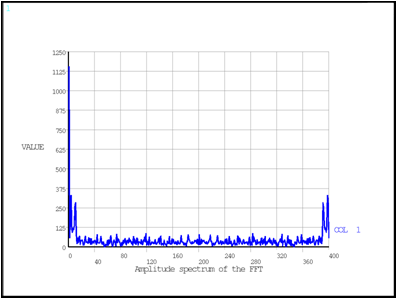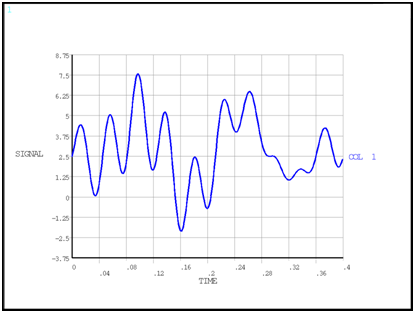*FFT, Type, InputData, OutputData, DIM1, DIM2, ResultFormat
Computes the fast Fourier transformation of a specified
matrix or vector.
Argument Descriptions
TypeType of FFT transformation:
- FORW --
Forward FFT computation (default).
- BACK --
Backward FFT computation.
InputDataName of matrix or vector for which the FFT will be computed. This can be a dense matrix (created by the *DMAT command) or a vector (created by the *VEC command). Data can be real or complex values. There is no default value for this argument.
OutputDataName of matrix or vector where the FFT results will be stored. The type of this argument must be consistent with
InputData(see table below). There is no default value for this argument.FFT Domain Forward Backward Input Data Output Data Input Data Output Data Real Real Complex Complex Real Complex Complex Complex Complex Complex DIM1The number of terms to consider for a vector, or the number of rows for a matrix. Defaults to the whole input vector or all the rows of the matrix.
DIM2The number of columns to consider for a matrix. Defaults to all the columns of the matrix. (Valid only for matrices.)
ResultFormatSpecifies the result format:
- FULL --
Returns the full result. That is, the result matches the dimension specified on this command (
DIM1,DIM2).- PART --
Returns partial results. For real input data, there is a symmetry in the results of the Fourier transform as some coefficients are conjugated. The partial format uses this symmetry to optimize the storage of the results. (Valid only for real data.)
Notes
In the example that follows, the fast Fourier transformation is used to filter frequencies from a noisy input signal.
Example Usage
The fast Fourier transformation can be used to create a filter to remove noise from a noisy input signal.
The input signal is decomposed in the Fourier space using the *FFT,FORW command so that the
frequencies that compose the signal can be observed.
The filter applies a threshold on the Fourier coefficients.
Fourier coefficients of small amplitude are the result of the noise
in the input signal. Only coefficients of a large amplitude are significant.
The inversion of the *FFT command (*FFT,BACK command) rebuilds the signal from
the remaining coefficients.
Example input demonstrating *FFT usage is provided below:
/com,*************************************************
/com,* Usage example of the *FFT APDLMath command. *
/com,* Use FFT to filter a noisy sinusoidal signal. *
/com,*************************************************
/verify
/nopr
/post26
/gopr
/com, *** Definition of the parameters for the signal
pi = acos(-1)
periode1 = 2*pi/40.0
phase1 = 4.0
amplitude1 = 2.5
periode2 = 2*pi/150.0
phase2 = 0.0
amplitude2 = 2.0
periode3 = 2*pi/140.0
phase3 = 0.0
amplitude3 = 1.5
amplitudenoise = 6.0
n = 400 !number of points in the sampling input signal
tbegin = 0.0 !start time for the signal
dt = 0.001 !time step
tend = tbegin + (n-1)*dt
/com, *** Definition of the parameters
threshold = 150.0
FFTmethod = 1 !0 = FFT giving partial results , 1 = FFT giving full results
/com, *** Create a signal from two sinus and add noise
*dim,signal,array,n
*dim,t,array,n
*dim,noise,array,n
*vfill,noise,rand
omega1 = (2.0*pi) / periode1
omega2 = (2.0*pi) / periode2
omega3 = (2.0*pi) / periode3
*do,ii,1,n
noisec = amplitudenoise * noise(ii)
tc = tbegin + (ii-1)*dt
t(ii) = tc
signal(ii) = amplitude1*sin(omega1*tc+phase1)
+ amplitude2*sin(omega2*tc+phase2)
+ amplitude3*sin(omega3*tc+phase3)
+ noisec
*enddo
/com, *** Display the input signal
*dim,signaldisp,table,n
*dim,tdisp,table,n
*do,ii,1,n
tdisp(ii)=t(ii)
signaldisp(ii)=signal(ii)
*enddo
/show,png
/AXLAB,X,TIME
/AXLAB,Y,SIGNAL
/color,curve,BLUE
/color,grbak,WHIT
/color,wbak,WHIT
/color,axes,BLAC
/color,axlab,BLAC
/color,axnum,blac
/GROPT,FILL,OFF
*vplot,tdisp,signaldisp
/com, *** Copy signal in an APDLMath vector
*vec,sigvec,d,alloc,n,1
*do,ii,1,n
sigvec(ii) = signal(ii)
*enddo
/com, *** Perform a Fast Fourier Transform
*vec,VFFT,Z,ALLOC,n,1
*if,FFTmethod,eq,0,then
*FFT,FORW,sigvec,VFFT,,,PART !partial FFT (use symmetry properties)
*else
*FFT,FORW,sigvec,VFFT,,,FULL !full FFT
*endif
/com, *** Determine the real part and the imaginary part of the Fourier's coefficients
*vec,VFFTI,Z,COPY,VFFT
*AXPY,,,,0.,-1.,VFFTI
*vec,VI,D,COPY,VFFTI
*vec,VR,D,COPY,VFFT
/com, *** Compute the modulus of the Fourier's coeff
*EXPORT,VR,APDL,fftr
*EXPORT,VI,APDL,ffti
sizeVR = VR_rowDim
*if,FFTmethod,eq,0,then
sizeVR = sizeVR/2
*endif
*dim,ind,table,sizeVR
*dim,modfft,array,sizeVR
*do,ii,1,sizeVR
ind(ii) = ii
modfft(ii)= sqrt( fftr(ii)*fftr(ii) + ffti(ii)*ffti(ii) )
*enddo
/com,*** Display the Amplitude spectrum of the FFT
*dim,modfftdisp,table,sizeVR
*do,ii,1,sizeVR
modfftdisp(ii) = modfft(ii)
*enddo
/show,png
/AXLAB,X,Amplitude spectrum of the FFT
/AXLAB,Y,
*vplot,ind,modfftdisp
fini
/com, *** Threshold on Fourier coefficients
*print,VR
*do,ii,1,sizeVR
module = modfft(ii)
*if,module,lt,threshold,then
VR(ii) = 0.0
VI(ii) = 0.0
*endif
*enddo
/com, *** Invert Fourier Transform
*vec,VIFT,Z,COPY,VR
*AXPY,0.0,1.0,VI,1.0,0.0,VIFT
*vec,VFILTER,D,ALLOC,sizeVR
*FFT,BACK,VIFT,VFILTER
/com, *** Display the filtered signal
*EXPORT,VFILTER,APDL,filterSignal
*dim,fsignal,table,sizeVR
*do,ii,1,sizeVR
fsignal(ii) = filterSignal(ii)
*enddo
/show,png
/AXLAB,X,TIME
/AXLAB,Y,SIGNAL
*vplot,tdisp,fsignal
fini
/com, *** Free the APDLMath objects
*free,all

